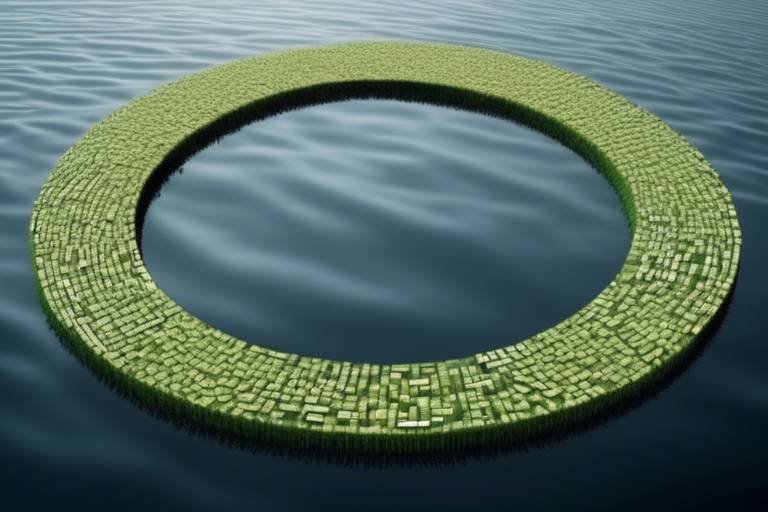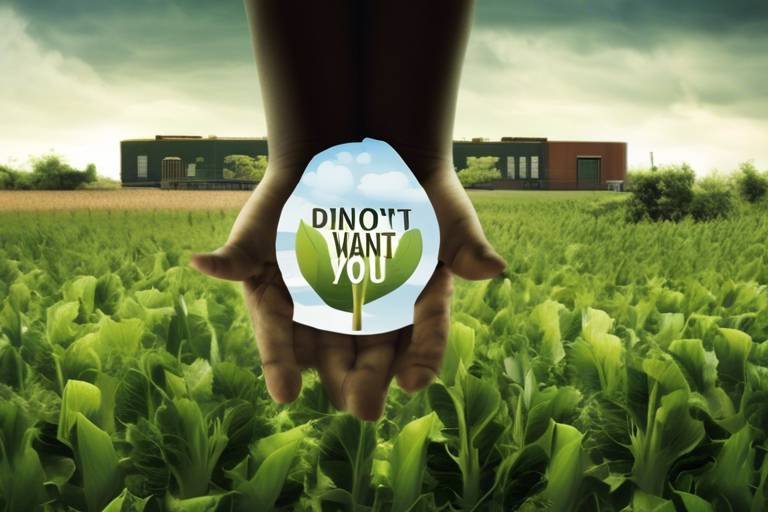Understanding the Concept of a Circular Economy
In today's world, the concept of a circular economy is gaining momentum as a sustainable model that aims to revolutionize how we utilize resources. Instead of the traditional linear economy, which follows a 'take-make-dispose' pattern, a circular economy focuses on minimizing waste and maximizing resources through practices such as recycling, reuse, and regeneration of products and materials. It's like a never-ending dance where resources are constantly in motion, serving multiple purposes and extending their lifespan.
Imagine a world where products are not discarded after a single use but are designed to be cyclical, where the end of one product's life marks the beginning of another. This shift in mindset from a linear to a circular approach holds the promise of environmental preservation, economic growth, and social well-being. By understanding the fundamental principles and benefits of a circular economy, we can pave the way for a more sustainable future for generations to come.

History of Circular Economy
The history of the circular economy dates back to the 1970s when the concept was first introduced by environmentalists seeking alternative economic models that prioritize sustainability and resource efficiency. Over the years, the idea has evolved from a niche concept to a mainstream approach embraced by businesses, governments, and environmental advocates worldwide. Early pioneers of the circular economy, such as Walter Stahel and the Ellen MacArthur Foundation, played a crucial role in shaping the principles and practices that define this innovative economic model.
One of the key milestones in the history of the circular economy was the publication of the book "Cradle to Cradle: Remaking the Way We Make Things" by William McDonough and Michael Braungart in 2002. This influential book introduced the idea of designing products and systems that mimic nature's closed-loop cycles, where waste is minimized, and resources are continuously reused and regenerated. The principles outlined in "Cradle to Cradle" laid the foundation for a new era of sustainable design and production practices.
As awareness of environmental issues and resource scarcity grew in the early 21st century, governments and businesses began to recognize the potential of the circular economy to address these challenges. The European Union has been at the forefront of promoting circular economy policies, setting ambitious targets for waste reduction, recycling, and resource efficiency. Countries around the world are now exploring ways to transition from a linear "take-make-dispose" model to a circular economy that promotes long-term sustainability and resilience.

Key Principles of Circular Economy
The key principles of a circular economy revolve around the core concepts of sustainability and resource optimization. One fundamental principle is designing out waste, which involves creating products that are durable, repairable, and recyclable to minimize the generation of waste. By implementing this principle, companies can reduce their environmental impact and contribute to a more sustainable future.
Another key principle is keeping products and materials in use for as long as possible. This involves extending the lifespan of products through repair, refurbishment, and sharing initiatives. By maximizing the utility of products, resources are utilized more efficiently, reducing the need for constant production and consumption.
Additionally, the principle of regenerating natural systems emphasizes the importance of restoring and replenishing ecosystems affected by human activities. This involves implementing regenerative practices that promote biodiversity, soil health, and ecosystem resilience. By integrating regenerative principles into business operations, companies can support environmental restoration and conservation efforts.
In a circular economy, these principles work together to create a closed-loop system where resources are continuously circulated and reused, minimizing waste and maximizing the value of materials. By embracing these key principles, businesses and communities can transition towards a more sustainable and resilient economic model that benefits both the environment and society.

Resource Efficiency
Exploring the principles and benefits of a circular economy, a sustainable model that aims to minimize waste and maximize resources through recycling, reuse, and regeneration of products and materials.
Tracing the origins and evolution of the circular economy concept, from early ideas to modern-day strategies for achieving a more sustainable and efficient economic system.
Examining the core principles that guide the circular economy framework, including designing out waste, keeping products and materials in use, and regenerating natural systems.
In a circular economy, resource efficiency plays a crucial role in optimizing the use of resources and reducing environmental impact. By implementing efficient production processes and innovative technologies, businesses can minimize resource wastage and enhance sustainability. For example, companies can adopt practices such as energy-efficient manufacturing, waste reduction strategies, and material recycling to ensure that resources are utilized effectively.
Closed-loop systems are integral to the concept of a circular economy. These systems involve designing products that can be reused or recycled multiple times, thereby reducing the need for new resources and minimizing waste generation. By creating products with longevity and recyclability in mind, businesses can contribute to resource conservation and promote a more sustainable approach to production and consumption.
Discussing the environmental, economic, and social benefits of transitioning to a circular economy, such as reduced greenhouse gas emissions, job creation, and enhanced resource security.
Addressing the role of sustainable consumption and production practices in promoting a circular economy, encouraging responsible consumer behavior and eco-friendly manufacturing processes.
Identifying the challenges and barriers to implementing a circular economy, including policy gaps, technological limitations, and cultural resistance to change.
Exploring the importance of innovation and collaboration among stakeholders, governments, businesses, and consumers to overcome challenges and drive the transition to a circular economy.
Stay tuned for the frequently asked questions section at the end of this article for more insights and answers to common queries about the circular economy.

Closed-Loop Systems
Closed-loop systems are at the core of the circular economy concept, emphasizing the importance of designing products for durability and multiple life cycles. In a closed-loop system, products are created with the intention of being reused, refurbished, or recycled at the end of their initial use, rather than being disposed of as waste. This approach aims to minimize the extraction of new resources and reduce the generation of waste, promoting a more sustainable and efficient use of materials.

Benefits of a Circular Economy
Embracing a circular economy offers a myriad of benefits that extend beyond just environmental sustainability. By transitioning to this model, societies can significantly reduce their carbon footprint, contributing to the global fight against climate change. Furthermore, the circular economy promotes resource efficiency, which not only conserves valuable materials but also helps in the preservation of natural ecosystems. Economically, this approach fosters innovation and job creation, paving the way for a more resilient and competitive market.
One of the key advantages of a circular economy is the enhancement of resource security. By keeping resources in use for longer periods through recycling and reuse, the reliance on finite resources diminishes, thereby ensuring a more stable supply chain. This not only mitigates the risks associated with resource scarcity but also reduces the dependency on imports, fostering self-sufficiency and resilience in the face of global market fluctuations.
Moreover, transitioning to a circular economy can lead to significant cost savings for businesses and consumers alike. By extending the lifespan of products and materials, companies can minimize production costs and waste disposal expenses. Consumers, on the other hand, benefit from access to high-quality, durable goods at lower prices, aligning with the principles of sustainable consumption and responsible consumer behavior.
Additionally, the social benefits of a circular economy should not be overlooked. This model promotes a shift towards more equitable and inclusive societies by creating opportunities for marginalized communities and promoting fair labor practices. By prioritizing the well-being of both people and the planet, the circular economy fosters a more balanced and harmonious relationship between economic development and social progress.

Sustainable Consumption and Production
Sustainable consumption and production play a crucial role in driving the transition towards a circular economy. By embracing eco-friendly practices and promoting responsible consumer behavior, individuals and businesses can contribute to minimizing waste and maximizing resource efficiency. This involves choosing sustainable products, reducing energy consumption, and supporting ethical production methods.
One key aspect of sustainable consumption is making informed choices that prioritize environmental and social impacts. This includes opting for products with minimal packaging, choosing items that are long-lasting and repairable, and supporting companies with transparent and sustainable supply chains.
On the production side, adapting manufacturing processes to be more sustainable is essential. This can involve implementing renewable energy sources, reducing water usage, and minimizing emissions and waste generation. By adopting circular design principles and closed-loop systems, companies can optimize resource use and reduce their environmental footprint.

Challenges and Barriers
Implementing a circular economy poses several challenges and barriers that need to be addressed for a successful transition. One significant challenge is the existing policy gaps that hinder the widespread adoption of circular practices. Governments and regulatory bodies play a crucial role in creating a conducive environment through supportive policies and regulations.
Technological limitations also present obstacles to fully realizing the potential of a circular economy. Developing advanced technologies for recycling, remanufacturing, and resource recovery is essential for closing the loop and minimizing waste generation. Investment in research and development is key to overcoming these technological barriers.
Cultural resistance to change is another barrier that must be overcome. Shifting from a linear to a circular economy requires a fundamental change in mindset and behavior at both individual and organizational levels. Education, awareness campaigns, and incentives can help in fostering a culture of sustainability and circularity.
Collaboration among stakeholders is crucial for addressing the challenges and barriers associated with transitioning to a circular economy. Businesses, governments, academia, and consumers need to work together to drive innovation, share best practices, and create a supportive ecosystem for circular initiatives.
Furthermore, the lack of standardized metrics and measurement tools for evaluating circularity poses a challenge in assessing the progress and impact of circular economy initiatives. Establishing clear metrics and reporting frameworks is essential for tracking performance and driving continuous improvement.

Innovation and Collaboration
Innovation and collaboration are the driving forces behind the successful implementation of a circular economy. In this dynamic model, innovation plays a crucial role in developing new technologies, processes, and business models that support sustainability and resource efficiency. By fostering a culture of creativity and out-of-the-box thinking, businesses and organizations can find innovative solutions to complex environmental challenges.
Furthermore, collaboration among various stakeholders is essential for creating a network of support that enables the exchange of ideas, expertise, and resources. When businesses, governments, academia, and communities come together, they can leverage their strengths to address common goals and drive collective action towards a more sustainable future.
Through open communication and partnerships, different entities can share knowledge, best practices, and lessons learned to accelerate the transition to a circular economy. By working together towards shared objectives, stakeholders can overcome barriers, maximize impact, and create a ripple effect of positive change across industries and sectors.
Frequently Asked Questions
- What is a circular economy?
A circular economy is a sustainable economic model that aims to minimize waste and maximize resources by promoting recycling, reuse, and regeneration of products and materials. It focuses on keeping products and materials in use for as long as possible and designing out waste from the production process.
- Why is a circular economy important?
A circular economy is important because it offers environmental, economic, and social benefits. By reducing waste generation, promoting resource efficiency, and encouraging sustainable consumption and production practices, a circular economy can help mitigate climate change, create new job opportunities, and enhance resource security for future generations.
- What are the key principles of a circular economy?
The key principles of a circular economy include designing out waste, keeping products and materials in use, and regenerating natural systems. These principles guide the transition towards a more sustainable and efficient economic system that aims to minimize environmental impact and maximize resource productivity.
- How can individuals contribute to a circular economy?
Individuals can contribute to a circular economy by practicing responsible consumption habits, such as buying durable and eco-friendly products, recycling and repurposing items, and supporting businesses that prioritize sustainability. By making conscious choices in their daily lives, individuals can help drive the transition towards a more circular and sustainable economy.
- What are the challenges to implementing a circular economy?
Challenges to implementing a circular economy include policy gaps, technological limitations, and cultural resistance to change. Overcoming these challenges requires collaboration and innovation among stakeholders, governments, businesses, and consumers to develop and implement effective strategies for transitioning to a circular economic model.



















